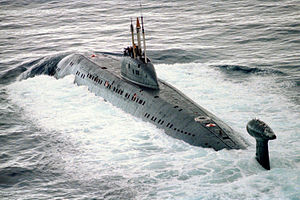Soviet submarine K-324
 A Victor III-class submarine similar to K-324
| |
| History | |
|---|---|
| Name | K-324 |
| Builder | Komsomolsk Shipyard, Komsomolsk-on-Amur |
| Laid down | 1979 |
| Decommissioned | 1997 |
| Status | In reserve |
| General characteristics | |
| Class and type | Victor III-class submarine |
| Displacement |
|
| Length | 93–102 m (305 ft 1 in – 334 ft 8 in) |
| Beam | 10 m (32 ft 10 in) |
| Draft | 7 m (23 ft 0 in) |
| Propulsion | One VM-4P pressurized-water twin nuclear reactor (2x75 MW), 2 sets OK-300 steam turbines; 1 7-bladed or 2 4-bladed props; 31,000 shp (23,000 kW) at 290 shaft rpm—2 low-speed electric cruise motors; 2 small props on stern planes; 1,020 shp (760 kW) at 500 rpm Electric: 4,460 kw tot. (2 × 2,000-kw, 380-V, 50-Hz a.c. OK-2 turbogenerators, 1 × 460-kw diesel emergency set |
| Speed | 32 knots (59 km/h; 37 mph) |
| Endurance | 80 days |
| Complement | About 100 (27 officers, 34 warrant officers, 35 enlisted) |
| Sensors and processing systems |
|
| Armament | 4 bow torpedo tubes, 533 mm (21 in) (16 weapons - Type 83RN/Type 53-65K/USET-80 torpedoes, Type 84RN/SS-N-15 Starfish cruise missiles, VA-111 Shkval rocket torpedoes, MG-74 Korund and Siren decoys, or up to 36 naval mines) |
K-324 was a Soviet Navy Victor III-class submarine in reserve since 1997. It was assigned to the Northern Fleet.
Service history
[edit]K-324's keel was laid down on 29 February 1980 at Komsomolsk Shipyard in Komsomolsk-on-Amur in the Russian Far East. It was launched on 7 October 1980 and commissioned on 30 December 1980. It was the seventh submarine of the class built at Komsomolsk.
Collision
[edit]In 1981, K-324 collided with an unidentified submarine of the Sturgeon class, purportedly USS Drum, in Peter the Great Bay, not far from Vladivostok.[1] The submarine was heavily damaged, to all reports. The United States government denied any of their submarines were in the area, and no US submarine reported any damage during that time period, but the Soviets reported none of their submarines were in the Bay aside from K-324.[citation needed]
Fleet transfer and operations
[edit]K-324 transited across the Arctic in November and was officially transferred to the Northern Fleet on 3 December 1982.
Disabled
[edit]
On 31 October 1983, K-324 snagged the US frigate USS McCloy's towed sonar array cable[2] 282 miles (454 km) west of Bermuda, causing damage to the submarine's propeller. The submarine was towed to Cienfuegos, Cuba for repairs by a Soviet salvage ship beginning on 5 November.[3] Soviet technicians recovered some parts of McCloy's array.[4]
Later activities and decommissioning
[edit]K-324 was again involved in operations around US waters in 1985. She was reported to have detected American SSBNs on three occasions, tailing them for 28 hours. K-324 took advantage of temperature variations in the Gulf Stream.[5] K-324 was in reserve by 1997.[6] K-324 was written off in 2000 for scrapping.
References
[edit]- ^ Reed, W. Craig (2020). Spies of the Deep. US: Permuted Press. pp. Chapter 4. ISBN 978-1682618011.
- ^ Norman Polmar, Kenneth J. Moore. Cold War Submarines: The Design and Construction of U.S. and Soviet. 2003. ISBN 1-57488-594-4.
- ^ Navysite.de - FF-1038.
- ^ Polmar, Norman and Moore, Kenneth (2004). Cold War Submarines: the design and construction of U.S. and Soviet submarines. Brassey's, p. 160. ISBN 1-57488-594-4
- ^ Thompson, Roger (2007). Lessons not learned: the U.S. Navy's status quo culture. Naval Institute Press, p. 91. ISBN 1-59114-865-0
- ^ Project 671 Victor class Archived 2011-09-25 at the Wayback Machine Federation of American Scientists
